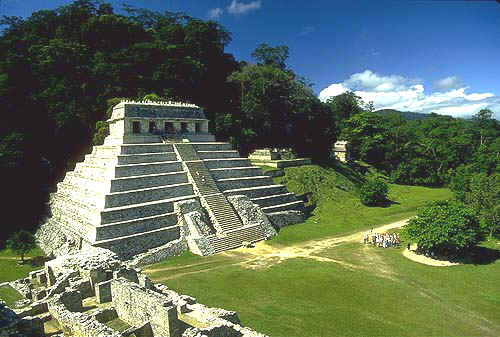Return
to Main Page
Return
to Index Page
 The Temple of the Inscriptions, Mayan ruins of Palenque, Mexico.
Vast, mysterious
and enchanting, the ruined city of Palenque is considered to be the
most beautifully
conceived of the Mayan city-states and one of the loveliest
archaeological
sites in the world. Its geographic setting is splendid beyond words.
Nestled amidst
steep and thickly forested hills, the ruins are frequently shrouded in
lacy mists.
A rushing brook meanders through the city center and from the temple
summits there
are stupendous views over an immense coastal plain. Here and there,
piercing the
dark green forests, soar great pyramids, towers and sprawling temple
complexes.
In its period of cultural florescence however, Palenque was even more
beautiful,
for then its limestone buildings were coated with white plaster and painted
in
a rainbow of
pastel hues. These fabulous ruins were so hidden in the jungles that their
existence was
unknown until 1773. Even then, Palenque was discovered and lost
several times
until 1841 when the explorers Stephens and Catherwood arrived and
described it
in detail.
Scattered pottery
shards show that the site was occupied from as early as 300 BC, but
most of the
buildings were constructed between the 7th and 10th centuries AD. Then,
mysteriously,
the great city was abandoned and reclaimed by the inexorable claws of
the jungle.
Even the Mayan name of the city was lost, and the ruins received their
current name
from the nearby village of Santo Domingo de Palenque. While the ruins
have received
some of the most extensive excavation and reconstruction efforts of any
of the Mayan
sites, only 34 structures have been opened of an estimated 500 that are
scattered around
the area. As one wanders through the ruins or gazes from atop the tall
buildings,
small hills are seen everywhere about the site. These are not hills however,
but Mayan structures
long overgrown with jungle.
The photograph
shows the so-called Temple of the Inscriptions. Erected in 692 AD, it
was originally
an eight storey platform later converted into a three-tier pyramid. In
1952
an amazing
discovery was made inside this pyramid. Beneath the slab floor of an inner
room was found
a stairway leading down to a funerary crypt 80 feet (24 m) below. The
crypt contained
a coffin with a skeleton covered with jade ornaments and other
precious jewels.
Inscriptions reveal the burial to have been of the great priest/king
Pacal Votan
who ruled the city from 615-683 AD. It is interesting to note that since
the
coffin is too
large to maneuver down the staircase, the crypt must have been
constructed
prior to the pyramid that now covers it. This fascinating structure, both
temple and
tomb, was the primary sacred site in Palenque and one of the most visited
pilgrimage
shrines in the vast Mayan territories.
The Temple of the Inscriptions, Mayan ruins of Palenque, Mexico.
Vast, mysterious
and enchanting, the ruined city of Palenque is considered to be the
most beautifully
conceived of the Mayan city-states and one of the loveliest
archaeological
sites in the world. Its geographic setting is splendid beyond words.
Nestled amidst
steep and thickly forested hills, the ruins are frequently shrouded in
lacy mists.
A rushing brook meanders through the city center and from the temple
summits there
are stupendous views over an immense coastal plain. Here and there,
piercing the
dark green forests, soar great pyramids, towers and sprawling temple
complexes.
In its period of cultural florescence however, Palenque was even more
beautiful,
for then its limestone buildings were coated with white plaster and painted
in
a rainbow of
pastel hues. These fabulous ruins were so hidden in the jungles that their
existence was
unknown until 1773. Even then, Palenque was discovered and lost
several times
until 1841 when the explorers Stephens and Catherwood arrived and
described it
in detail.
Scattered pottery
shards show that the site was occupied from as early as 300 BC, but
most of the
buildings were constructed between the 7th and 10th centuries AD. Then,
mysteriously,
the great city was abandoned and reclaimed by the inexorable claws of
the jungle.
Even the Mayan name of the city was lost, and the ruins received their
current name
from the nearby village of Santo Domingo de Palenque. While the ruins
have received
some of the most extensive excavation and reconstruction efforts of any
of the Mayan
sites, only 34 structures have been opened of an estimated 500 that are
scattered around
the area. As one wanders through the ruins or gazes from atop the tall
buildings,
small hills are seen everywhere about the site. These are not hills however,
but Mayan structures
long overgrown with jungle.
The photograph
shows the so-called Temple of the Inscriptions. Erected in 692 AD, it
was originally
an eight storey platform later converted into a three-tier pyramid. In
1952
an amazing
discovery was made inside this pyramid. Beneath the slab floor of an inner
room was found
a stairway leading down to a funerary crypt 80 feet (24 m) below. The
crypt contained
a coffin with a skeleton covered with jade ornaments and other
precious jewels.
Inscriptions reveal the burial to have been of the great priest/king
Pacal Votan
who ruled the city from 615-683 AD. It is interesting to note that since
the
coffin is too
large to maneuver down the staircase, the crypt must have been
constructed
prior to the pyramid that now covers it. This fascinating structure, both
temple and
tomb, was the primary sacred site in Palenque and one of the most visited
pilgrimage
shrines in the vast Mayan territories.

